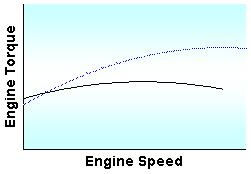| |
|
|
| |
|
|
Increasing
the size of the inlet valve increases the amount of fuel
air mixture that is allowed to enter the combustion chamber.
Increasing this mixture flowing into the combustion chamber
means that when engine speeds are at the higher end of the
scale the extra mixture is enough to fill the combustion
chamber, unlike standard valves. This results in greater
torque and power at higher revs for larger valves. At the
lower end of the scale the larger inlet valves would result
in a slight decrease in torque. Displayed in graphs below. |
|
|
|
| |
| |
Engine Torque and Power Outputs
Measured Against Engine Speed Using Standard and Increased
Sized Valves |
|
|
| |
| |
Exhaust
valve a smaller diameter that the inlet valve |
|
In
normally aspirated combustion engines it is general practice
to make the exhaust valve a smaller diameter that the inlet
valve. This is because the piston forcibly expels the exhaust
gases, whereas the inlet air is drawn in. On an engine with
carburettors fitted the largest pressure pushing into the
cylinder is in the region of 15lb per square inch. On the
exhaust side there is generally up to 80lbs per square inch
in the cylinder when the exhaust valve opens, so the exhaust
valves should not be made bigger at the expenses of the intake
valves. This is not the case when dealing with supercharged
or turbo charged engines where the fuel air mixture is forcibly
brought into the cylinder. |
|
|
|
| |
|
|
| |
|
|
| |
| Three-angled
Valve Seats
Three-angled
seat valves help the flow of the mixture into the combustion
chamber because of their modified shape. As their name suggests
these valve seats are made up of three angles. The various
angles allow less obstruction to the flow of the air fuel
mixture into the combustion chamber see below. This improves
the breathing of an engine and therefore the power output. |
|
|
|
| |
|
|
| |
Fillet
Radius reduction
Shown
below is the blockage that a fillet radius can impose upon
the flow of fluids. The fillet radius can be reduced to minimise
this blockage. However it must not be made too small, as it
is needed for strength. |
|
|
|
| |
|
|
| |
|
|
| |
|
|
